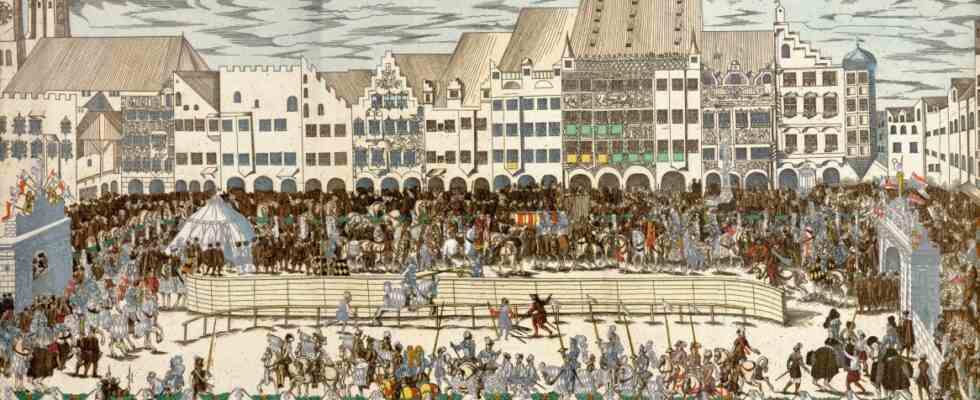Duels are fought to the bitter end, even to the point of losing a limb, and then you can still settle for a draw. This scene in the knight film satirization “Monty Python and the Holy Grail” (“The Knights of the Coconut”, 1975) is of legendary British sportsmanship, a wonderful nonsense in which historically nothing is true, but through the cheerful glasses the satire hits the point astutely: the world of knights fascinates to this day.
A studio exhibition can now be seen in the Bavarian National Museum, which, with exhibits from its own collection, draws an exciting line from the tournament events of the 15th and 16th centuries to the major sporting events of modern times. For the “Game of Thrones” generation, this contribution of medieval studies to the anniversary year of the Olympic Games in Munich 72 may come across as a bit too academic. But at least you can see on monitors how the members of the French stunt troupe “Cavalcade” spectacularly crash into the arena dust from snorting horses. The Kaltenberg Knights’ Tournament is a co-sponsor of the exhibition.
The live spectacle can take place again this year after a two-year Corona break (start July 15). Luitpold Prince of Bavaria brought the tournament to life in 1980 on the occasion of the 800th anniversary of the House of Wittelsbach on his palace grounds and thus restages history, just as happens regularly at celebrations of the Landshut wedding. “Despite all the undeniable differences, the historic competitions of the nobility and the major sporting event of the modern age have a remarkable number of similarities,” writes Frank Matthias Kammel, Director General of the Bavarian National Museum, in the exhibition catalogue.
And he sees astonishing parallels: Both the show fights five centuries ago and the Olympics five decades ago were about physical strength, technique and agility, about representation of power, be it of noble families or nations. Even then there were rules of the game and referees, battlefields, roaring crowds, immeasurable costs, waving banners, lavish decor, which, according to Kammel, is certainly quoted in Otl Aicher’s overall aesthetic concept for Munich ’72. In addition, the games were, then as now, of course, a marriage market – keyword Silvia Sommerlath.
Riders in silk underwear
Unique exhibit: This equestrian figure from the possession of the Nuremberg patrician Holzschuher family was probably a toy for young men. It is attributed to Anton Peffenhauser from Augsburg and was made around 1570.
(Photo: Bastian Krack/Bavarian National Museum)
At least in the Middle Ages, women played no role, apart from handing out laurel wreaths. A man thing. And even the boys should grow into the world of the noble showdown, as an exhibit shows. The small horseman from the house of the Nuremberg patrician Holzschuher family (mid-16th century) was probably a toy, says Raphael Beuing. He is curator of the exhibition and responsible for the weapons collection in the museum. X-rays taken in preparation for the show revealed amazing things.
Wearing silk briefs under yellow leather slit pants, mini rider is adjustable to wire fingertips. And according to Beuing, the fact that linen blinding caps were put on the horses in battle is only known from this figure, which is probably unique in the world of museums: “A hitherto completely unknown part of the horse’s armor, which was supposed to block the horse’s view during the stabbing and protect it from to shy away from the opposing animal”.
Hidden object from the royal wedding
It doesn’t work without help: A spearman hands the lance to rider Christoph Scheurl in this detail from the depiction of the journeyman’s jousting in Nuremberg on March 3, 1561 by Jost Ammann.
(Photo: Bastian Krack/Bavarian National Museum)
The picture exhibits in the show are also rich in detail, early hidden object pictures that tell many stories. The event that the artist Jost Ammann captured with bravura and humor can be dated precisely: It shows a journeyman’s jousting on Nuremberg’s main market on March 3, 1561, which is carried out by young aristocratic or patrician peers. A curious crowd jostle for the best seats, one discovers judges with fur-trimmed coats, pedestals over which the knights in their heavy armor, supported by squires, heave themselves onto their horses.
There is also a lot going on in another painting: one of the greatest festivals of the Renaissance in southern Germany, accompanied by tournaments, was the marriage of Duke Wilhelm V of Bavaria to Renata of Lothringen in Munich in 1568, which followed in quick succession with banquets, dances, church services and all possible forms of tournaments were celebrated. Here, too, the artist Nikolaus Solis was on hand to document this party for posterity.
Fencing scene with a long sword: Joachim Meyer made these watercolor and pen drawings on paper probably around 1561 for Duke Georg Johann I, Count of Palatinate-Veldenz.
(Photo: Walter Haberland/Bavarian National Museum)
In addition to the exhibits from the weapons collection of the National Museum, those interested in martial arts should particularly like the large, landscape-format fencing books by Joachim Meyer, which are otherwise stored in the museum’s safes due to the sensitivity of the watercolors.
Published in Strasbourg in 1570 and in Augsburg in 1600, they show, almost like instructions, martial arts from a new perspective – because in the art of fencing it was no longer just young aristocrats who trained and competed, but also members of the city militia, soldiers, students and craftsmen . And in the show this seems to be the closest approach to the sport of today.
Tournament, competition and game, Bavarian National Museum, Prinzregentenstrasse 3, until November 6, 2022, www.bayerisches-nationalmuseum.de

